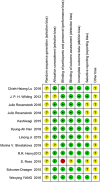The different hypoglycemic effects between East Asian and non-Asian type 2 diabetes patients when treated with SGLT-2 inhibitors as an add-on treatment for metformin: a systematic review and meta-analysis of randomized controlled trials
- PMID: 33973870
- PMCID: PMC8148508
- DOI: 10.18632/aging.202945
The different hypoglycemic effects between East Asian and non-Asian type 2 diabetes patients when treated with SGLT-2 inhibitors as an add-on treatment for metformin: a systematic review and meta-analysis of randomized controlled trials
Abstract
Aims: To investigate the efficacy and safety of SGLT-2 inhibitors as an add-on treatment for metformin between Asian and non-Asian T2DM.
Methods: A systematic literature search of PubMed, EMBASE, and the Cochrane Library was performed through August 2020 with the following keywords: Sodium-Glucose Transporter 2 Inhibitors, Sodium Glucose Transporter 2 Inhibitors, SGLT2 inhibitor, SGLT-2 inhibitors, type 2 diabetes, and randomized controlled trials. Double-blinded RCTs comparing SGLT-2 inhibitors as an add-on treatment for metformin and metformin monotherapy in adults with type 2 diabetes were included. A random effects model was used to calculate overall effect sizes.
Results: 5 RCTs with 1193 Asian patients and 7 RCTs with 2098 non-Asian patients were investigated. The improvement in HbA1c and fasting blood glucose in the Asian patients (WMD, -0.73%; 95% CI, -1.01% to -0.46%, p < 0.01; WMD, -1.51; 95% CI, -1.81 to -1.21, p < 0.01, respectively) were both significantly better than in the non-Asians (WMD, -0.45%; 95% CI, -0.62% to -0.29%, p < 0.01; WMD, -1.03; 95% CI, -1.27 to -0.78, p < 0.01, respectively). The effect of weight loss was similar in the non-Asian patients and Asian patients. There was little difference in the improvement of systolic blood pressure between them. The risk of serious adverse events was not significantly increased between the Asian and non-Asian patients.
Conclusion: SGLT-2 inhibitors as an add-on treatment for metformin are more efficacious in East Asian T2DM patients than in non-Asian T2DM patients without an additional risk of severe adverse events.
Keywords: Asian; SGLT-2 inhibitors; meta-analysis; metformin; randomized controlled trial; type 2 diabetes.
Conflict of interest statement
Figures








Similar articles
-
Efficacy and safety of a sodium-glucose co-transporter-2 inhibitor versus placebo as an add-on therapy for people with type 2 diabetes inadequately treated with metformin and a dipeptidyl peptidase-4 inhibitor: a systematic review and meta-analysis of randomised controlled trials.Diabet Med. 2021 Feb;38(2):e14409. doi: 10.1111/dme.14409. Epub 2020 Nov 28. Diabet Med. 2021. PMID: 32979231
-
Glucagon-like peptide-1 receptor agonists or sodium-glucose cotransporter-2 inhibitors as add-on therapy for patients with type 2 diabetes? A systematic review and meta-analysis of surrogate metabolic endpoints.Diabetes Metab. 2020 Sep;46(4):272-279. doi: 10.1016/j.diabet.2020.04.001. Epub 2020 May 8. Diabetes Metab. 2020. PMID: 32437914
-
Glycemic efficacy and safety of glucagon-like peptide-1 receptor agonist on top of sodium-glucose co-transporter-2 inhibitor treatment compared to sodium-glucose co-transporter-2 inhibitor alone: A systematic review and meta-analysis of randomized controlled trials.Diabetes Res Clin Pract. 2019 Dec;158:107927. doi: 10.1016/j.diabres.2019.107927. Epub 2019 Nov 13. Diabetes Res Clin Pract. 2019. PMID: 31733280
-
Cardiovascular safety and efficacy of metformin-SGLT2i versus metformin-sulfonylureas in type 2 diabetes: systematic review and meta-analysis of randomized controlled trials.Sci Rep. 2021 Jan 8;11(1):137. doi: 10.1038/s41598-020-80603-8. Sci Rep. 2021. PMID: 33420333 Free PMC article.
-
Efficacy and safety of the combination or monotherapy with GLP-1 receptor agonists and SGLT-2 inhibitors in Type 2 diabetes mellitus: An update systematic review and meta-analysis.Am J Med Sci. 2024 Dec;368(6):579-588. doi: 10.1016/j.amjms.2024.07.011. Epub 2024 Jul 6. Am J Med Sci. 2024. PMID: 38977245
Cited by
-
Modeling Chronic Kidney Disease in Type 2 Diabetes Mellitus: A Systematic Literature Review of Models, Data Sources, and Derivation Cohorts.Diabetes Ther. 2022 Apr;13(4):651-677. doi: 10.1007/s13300-022-01208-0. Epub 2022 Mar 15. Diabetes Ther. 2022. PMID: 35290625 Free PMC article. Review.
-
Comparative Efficacy and Safety of Oral Semaglutide in Asians and Non-Asians Patients with Type 2 Diabetes Mellitus: A Systematic Review and Meta-Analysis.Diabetes Ther. 2025 Mar;16(3):449-470. doi: 10.1007/s13300-024-01689-1. Epub 2025 Jan 11. Diabetes Ther. 2025. PMID: 39797937 Free PMC article.
-
Long-term comparison of renal and metabolic outcomes after sodium-glucose co-transporter 2 inhibitor or glucagon-like peptide-1 receptor agonist therapy in type 2 diabetes.BMC Med. 2024 Jul 2;22(1):273. doi: 10.1186/s12916-024-03483-z. BMC Med. 2024. PMID: 38956548 Free PMC article.
-
Empagliflozin-A Sodium Glucose Co-transporter-2 Inhibitor: Overview ofits Chemistry, Pharmacology, and Toxicology.Curr Diabetes Rev. 2024;20(10):e230124226010. doi: 10.2174/0115733998271026231127051545. Curr Diabetes Rev. 2024. PMID: 38265382 Review.
-
The impact of metformin on kidney disease progression and mortality in diabetic patients using SGLT2 inhibitors: a real-world cohort study.Cardiovasc Diabetol. 2025 Feb 28;24(1):97. doi: 10.1186/s12933-025-02643-6. Cardiovasc Diabetol. 2025. PMID: 40022102 Free PMC article.
References
-
- IDF. IDF DIABETES ATLAS 2019. https://www.diabetesatlas.org/en/.
-
- Buse JB, Wexler DJ, Tsapas A, Rossing P, Mingrone G, Mathieu C, D'Alessio DA, Davies MJ. 2019 Update to: Management of Hyperglycemia in Type 2 Diabetes, 2018. A Consensus Report by the American Diabetes Association (ADA) and the European Association for the Study of Diabetes (EASD). Diabetes Care. 2020; 43:487–93. 10.2337/dci19-0066 - DOI - PMC - PubMed
Publication types
MeSH terms
Substances
LinkOut - more resources
Full Text Sources
Other Literature Sources
Medical

